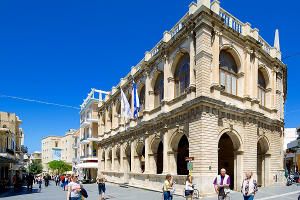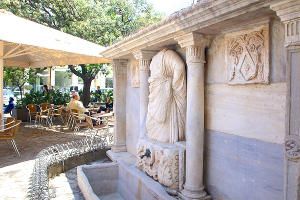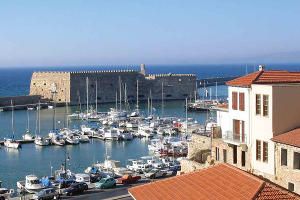Welcome to Heraklion, now the capital city and economic centre of Crete
Heraklion, Crete
In Minoan times, around 3,500 years ago, Heraklion was the port of the Minoan settlement at the Palace of Knossos. Today, it is the administrative and economic centre of the island of Crete.
The public bus takes about two hours from Georgioupolis to Heraklion. As the well-developed national road starts to descend after Agia Pelagia, you will see Crete's capital for the first time laid out before you in its full splendour. The huge sea of houses spreads across a vast plain, bordered on its outskirts by green hills and vineyards, as well as the Psiloritis range and the Lasithi mountains. One chain of hills is particularly prominent: the 811 m high Mount Juktas. In the right light and with enough imagination, you may see the silhouette of a bearded face. Some see the face of Zeus, father of the gods, who is said to be buried on the summit, according to legend.
The port and airport in Heraklion are the most important on the island; many international cruise ships also moor here
In Minoan times, around 3,500 years ago, Heraklion was the port of the Minoan settlement at the Palace of Knossos. Several centuries later, the Greeks then gave the city its current name. It derives from the mythical hero Heracles (Hercules). In the Venetian period, the city was called Candia, and was the administrative seat of the Serenissima. From 1851 to 1971 it was forced to cede its role as capital city to Chania, today it is once again the definitive administrative and economic centre of the island. Its port and its airport are the most important on the island; many international cruise ships also moor here.
Old Town Heraklion is particularly worth visiting. As a day visitor you have no need to leave the historic centre: it is enclosed on three sides by a medieval wall, and on the fourth by the sea, so that everything worth seeing and doing here is within comfortable walking distance for you to discover. For several years now, visiting the historic centre has been a very pleasant experience, because many previously busy streets have been turned into pedestrian zones. This means you can explore Heraklion without having to cross the traffic so often. You will find a great deal of cafés and tavernas and you will want for nothing. You are also sure to find the occasional souvenir.
A Day in Heraklion
A Tour of the Historic Centre
1 Pier - Koules Fortress
The bus station in Heraklion, where you will arrive, is situated right on the harbour road. Large car ferries and often giant cruise ships are moored here at the quays. From the bus station, walk 350 m westwards along the broad footpath and you will arrive at the old harbour basin from Venetian times, which was guarded by the well-preserved Koules Fortress. Sit like a Cretan in the café at the port, which belongs to the Yacht Club, as you order one of the many varieties of iced coffee: a traditional frappé, or the younger and trendier freddo espresso, or a freddo cappuccino. As you sit, you will enjoy a view of the Venetian walls, looking out over fishing and sailing boats and the harbour pier, more than 1 km long and popular with joggers.

2 Pedestrian Zone - Loggia - El. Venizelou Square
With a fresh burst of energy, head up the pedestrianised street, 25is Avgoustou from the small roundabout above the old port. It will first take you past the Church of Agiou Titou, which keeps relics of the patron saint of the island. Then you will pass the Loggia, the former meeting house of the Venetian aristocracy, and the Church of Agiou Markou, in which temporary art exhibitions are held these days. It is situated right on one of the city's two main squares, the Platia El. Venizelou. The special decorative piece in this square is a fountain, which the Venetian Governor Francesco Morosini commissioned to provide better drinking water to citizens in 1628.
On the south side of the square, two small confectioners 'Kirkor' and 'Filo...sophies' have specialised in a particular northern Greek delicacy for decades: Bougatsa. Bougatsa Krema is little pieces of strudel dough filled with a light semolina custard; Bougatsa Tiri is filled with savoury sheep's milk cheese.

3 Icon Exhibition - Traditional Market Street - Bembo Fountain
Now re-energized, head left as you leave the cafés, downhill on Odos Chandakos street. Right at the next street corner but one, you will find the atelier of the renowned icon painter Voula Manoussakis, who is happy for you to watch her at work and also enjoys conversing with visitors in English and a little German. From here, turn left into Odos Gramvoussas street, cross the road, and you will arrive at the small Church of Agias Ekaterinis with the most remarkable exhibition of icons on the island.
Behind the church, turn into Odos Kosmon street, cross Odos 1821 road and you will come across Heraklion's traditional market street, Odos 1821. Here, you can purchase Cretan souvenirs such as herbs, honey and wedding breads, buy freshly roasted Greek coffee, or simply enjoy Cretan market life. The best place to do so is the Kafenio at the Venetian Bembo Fountain on the southern end of the alley, where you will also find many locals.
For lunch, head westward back through the market street and turn right into the very short Odos Theodosaki street with its quaint market tavernas. There is an immense choice of meat, fish and vegetable dishes there, and good home cooking is the order of the day.

4 Shopping - Freedom Square - Archaeological Museum
Now it’s about time for some shopping. First go back to the Morosini Fountain and turn right into the pedestrianised Odos Daidalou street. Here you will find many good shops of all kinds. It opens onto the largest square in Heraklion, the Platia Eleftherias (Freedom Square). The Archaeological Museum rises up in the north-east corner of the square, with the largest collection of Minoan art worldwide. If you want to breeze through, you need at least 90 minutes; printed guides are available at the admissions desk.
If you want to return to Georgioupolis, it’s not far to the bus station at the port. Just follow Odos Beaufort street leading off the Platia Eleftherias down along the inner walls. You'll be at the bus station in 5 minutes.

5 Cafés & Rakadika
If you’d rather return on a later bus, you can also walk down Odos Beaufort, but turn into Odos Epimenidou street at the end. It will take you to Café Veneto, where you can enjoy your sundowner on the terrace with harbour views. Nibbles are also served with your wine.
If you want to sit down to a proper meal, continue along Odos Epimenidou street, cross the wide pedestrian zone on Odos 25is Avgoustou, which you already saw this morning, and go straight ahead. After 20 m, turn right into the narrow Odós Marinelli street. Severa Rakadika are here offering all kinds of typical Cretan and Greek dishes in small portions. You can order several of them with wine, preferably by the glass, or, of course, with Raki, from which this kind of taverna gets its name.
It’s then about 5-10 minutes’ walk to the bus station.

Museums of Crete
The Historical Museum, Heraklion
Situated in a historical building connected to a new wing, The Historical Museum of Crete displays a mishmash of objects from the Christian period of the island’s history. Before you even get to the admissions desk, you’ll see the figurehead of a 16th or 17th-century Venetian galley hanging to your right on the wall, with snakes draped across her shoulders. These animals seem to have always fascinated mankind. Here, they were probably intended to ward evil from the ship, like ancient Gorgons.
In Room 1 to the right of the admissions desk, there are six maps of Crete from the 16th-18th centuries displayed on the wall just to your left. All of them locate the famous Cretan labyrinth of the Minotaur in southern central Crete, and not at Knossos, as was typical in later maps.
Amateur weapons specialists will find something quite astounding beneath the three Venetian breast plates at the centre of the room: Venetian hand grenades made of glass, clay and copper are on display, meaning that hand grenades are not just the cruel invention of the 20th century.

Room 1 is dominated by a large model of the city of Iraklio (Heraklion). It maps the city, known as Chandax at the time, in a scale of 1:500 as it was in 1645, shortly before the Ottoman conquest.
As you enter Room 3 on the ground floor, a small slide show automatically begins with recordings of early Christian basilicas and Byzantine churches. In Room 4, the marble pulpit found in the 7th-century Basilica of St. Titus in Gortyna is vividly displayed in front of a large photo of the apse of this this famous church.
The pride of the museum are two small paintings by the famous Cretan painter El Greco: the 'Baptism of Christ' (1567) and the 'View of Mt. Sinai and the Monastery of St. Catherine' (1577). Both works, although unsigned, are considered to be originals. Because of the missing signature, they were affordable for this small museum. El Greco emigrated to Spain in 1577 and there are no others works by him on Crete!
A writing desk sits at the western end of the corridor on the first floor. Here sat the great Cretan writer Nikos Kazantzakis at work during his sojourn on the island of Aegina close to Athens. His whole study is even on display on the second floor, in which he worked from 1954 to 1957 in the little French town of Antibes.
For more information, visit the website of the Historical Museum in Heraklion
Learn more about
Nikos Kazantzakis
If you are a great fan of Kazantzakis, it might be worth your while to pay a visit to two other places in and around Heraklion.
Mirtia was his father’s home village. In 1983, a distant relation of Kazantzakis, the set and costume designer Giorgos Anemogiannis, set up a museum to Kazantzakis in the village. It outlines the eventful biography of the writer, displaying personal utensils, his works in all manner of languages, historical photos and letters and - of particular interest - original costumes and set designs for performances of his plays. For more information and current opening times, see: www.kazantzaki.gr
You will find not the tomb of the great writer, who died in 1957 in Freiburg/Breisgau, in a cemetery, but on the city walls of Iraklio. The church had refused him a Christian burial because he was regarded as a heretic by some clerics at that time.
You will find his grave on the Martinengo Bastion. A plain wooden cross and a simple gravestone with his own choice of words: 'I hope for nothing. I fear nothing. I am free' are the only ornaments at his grave, with the exception of the occasional flower. The Bastion is freely accessible during the day; you can reach it via Odos Nikolaou Plastira street.
Discover heavenly Crete for yourself
An island full of surprises
A holiday destination for bathing enthusiasts, nature lovers, hikers, and those interested in history and culture. Today, Crete is one of the most popular tourist destinations in the Mediterranean - cosmopolitan yet mysterious.
Popular hotels on the sandy beach
The Corissia Hotels are situated within the tranquil, picturesque village of Georgioupolis right on the sandy beach. An ideal seaside resort both to relax and explore the island, because that is just what holidays on Crete are all about.
Let yourself be pampered
 OUR BEST
OUR BEST